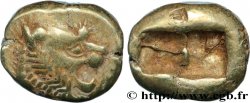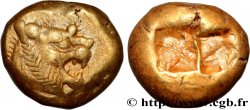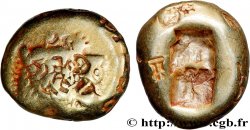bgr_760736 - LYDIA - LYDIAN KINGDOM Trité d’électrum
Not available.
Item sold on our e-shop (2023)
Price : 3 300.00 €
Item sold on our e-shop (2023)
Price : 3 300.00 €
Type : Trité d’électrum
Date: c. 610-550 AC.
Mint name / Town : Lydie, Sardes
Metal : electrum
Diameter : 11,5 mm
Orientation dies : - h.
Weight : 4,73 g.
Rarity : R2
Coments on the condition:
Monnaie centrée. Belle tête de lion. Fine usure régulière. Patine de collection
Catalogue references :
Obverse
Obverse legend : ANÉPIGRAPHE.
Obverse description : Tête de lion à droite, verrue sur le front (étoile).
Reverse
Reverse description : Double carré creux informe.








 Report a mistake
Report a mistake Print the page
Print the page Share my selection
Share my selection Ask a question
Ask a question Consign / sell
Consign / sell
 Full data
Full data


